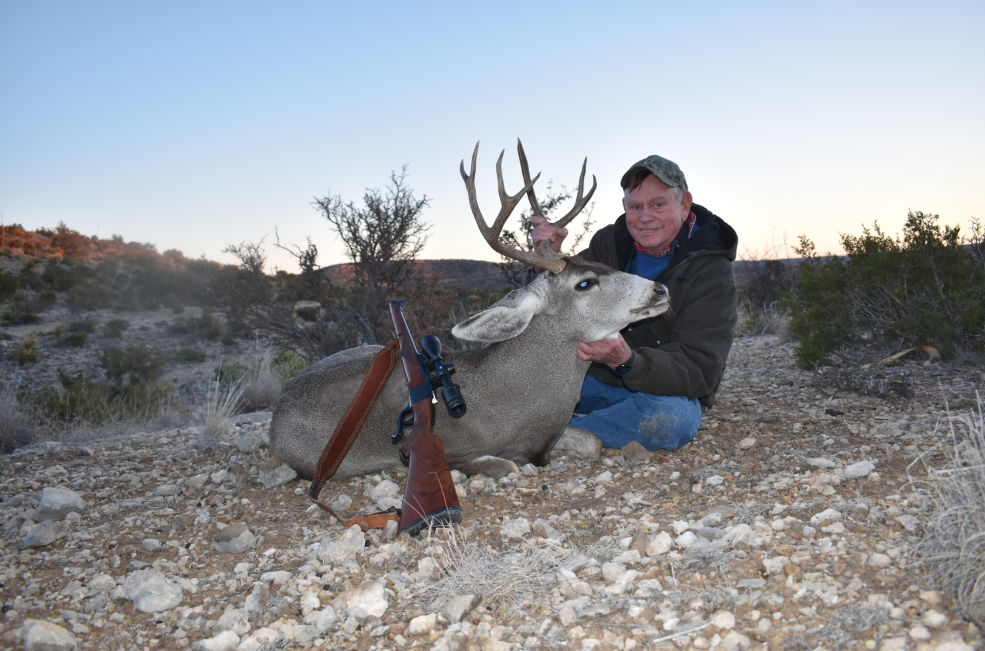Across the Pecos For Mule Deer
January 22, 2021



 Hunting,SCA Articles
Hunting,SCA Articles

If you have a Texas mule deer hunt on your bucket list, I can think of no better place than the Eason Ranch to cross it off.
Standing on the side of a mountain on the Eason Ranch, way out in Pecos County, I found myself somehow caught up in a time warp as I glanced across the vastness of distant mountains, just as the morning sun began to light them up. The day before, during the middle of the day after the morning hunt for mule deer, John Eason had given my friends Jeff Rice, Larry Weishuhn and I a tour of some of the ancient campsites that were scattered throughout the ranch. The feeling is difficult for me to describe but I felt almost as though the “ancients,” as Mr. Eason refers to inhabitants of his ranch many years ago, were calling out to me through the years. I’m sure my buddies were probably experiencing the same feelings.
This trip was a long time in the planning. Weishuhn and Eason had first met years ago when Larry was doing a mule deer seminar at Ft. Stockton. Eason and I met this past year during interviews for my weekly radio programs. I could tell we had a great deal in common and luckily we were able to find a hole in Weishuhn’s busy schedule so that we could all spend a few days together hunting mule deer with Eason. My running buddy Jeff Rice joined us for the hunt. Jeff loves to hunt, but I truly believe he loves capturing the essence of the outdoors with his video camera almost as much as the hunting and fishing experience itself.
The Eason Ranch encompasses thousands of acres and is home to a very healthy population of desert mule deer and whitetail; wild turkey and javelina also thrive in this beautiful high-desert country. Through the years, I have taken a few desert mule deer from this region and hunted the Rocky Mountain mule deer in higher elevations of Colorado and New Mexico.
Hunting mule deer in Texas has a lot of advantages over hunting in the mountain states. Distance and drive time are obviously big advantages to hunting in Texas. Most western states require hunters to apply for a mule deer tag in advance, but in Texas, the tags on our hunting license is all that is needed during the two-week season. Eason has his ranch under an MLD management plan, and hunting for mule deer begins with the opener of rifle season for whitetail in early November and runs through about the third week of January. The breeding season for mule deer is usually later than whitetail, and the extended seasons allow hunters to spend more time hunting bucks when they are on the move pursuing does.

Eason has stands and feeders well distributed throughout his ranch, but hunters may also take the hunt to the deer by glassing the mountains with optics and then stalking within rifle range. We mostly hunted from stands, and on the first afternoon hunt I got lucky and took a fine buck coming to a feeder in a remote canyon. Once a deer, either buck or doe, is sighted, I usually spend more time watching the deer than I do scanning the surrounding country for other deer. I’ve found through the years that the deer I’m watching will let me know through its body language of approaching game. Such was the case on this afternoon hunt.
A buck with a big fork on one antler and spike on the other slowly made his way to the feeding area. About fifty yards from the feeder, he stopped and pointed those big mule deer ears toward his back trail. Sure enough, in about ten minutes Jeff and I caught the glint of sunshine on antler and out walked a mature buck. Granted, there are bucks with larger headgear on the ranch than the one I shot, but this buck was fully grown, packing a lot of tasty venison and he was well within range. With a buck on the meat pole the first afternoon of the hunt, Jeff and I spent time with his video camera and taking still photographs. We carried my rifle on these excursions and Jeff was able to harvest a fat whitetail for his freezer. On one of our midday scouting excursions, Weishuhn made a good shot on a boar javelina. Many folks convince themselves that javelina are not good eating, but I’ve eaten several and found the meat to taste somewhat like a blend of wild hog and venison, it makes great fajitas or barbeque when slow cooked with moisture for several hours at low temperature.
Eason’s two sons, Shawn and Cameron traveled from their homes in Florida to visit during out hunt, and with them came some fresh alligator meat. The evening meal is always a big deal around hunting camp. One evening we feasted on fried gator chunks and ribeyes. I’ve eaten alligator at restaurants several times and never really liked it, but both times I’ve eaten really fresh alligator. Oddly enough, it was out in far west Texas and found it to be some of the best fried food I’ve had.
If you have a Texas mule deer hunt on your bucket list, I can think of no better place than the Eason Ranch to cross it off. I found the hospitality to be first class and the accommodations very comfortable. As Mr. Eason states, “Our camp house is very comfortable and the food, if our hunters wish us to do the cooking, very good, but it’s not a five-star lodge.” We all left the ranch making plans for round two with the mule deer next year. Eason also owns a ranch in New Mexico and offers trophy pronghorn hunts. John Eason welcomes your inquires about his hunting.
For more information, connect with John Eason lll on Facebook or call 863-781-1254.
